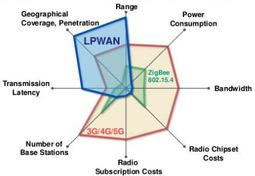Mioty Technology: Advantages and Disadvantages
Advertisement
Mioty technology is changing the Low Power Wide Area Network (LPWAN) landscape, providing a reliable, scalable, and energy-efficient communication solution for IoT applications. Built on the innovative Telegram Splitting Multiple Access (TSMA) protocol, Mioty tackles common issues like interference and network congestion.
This article explores the key advantages and disadvantages of Mioty, to help you understand its potential and limitations in the modern IoT ecosystem.
What is Mioty Technology?
Mioty is a sophisticated Low Power Wide Area Network (LPWAN) technology designed for robust and scalable communication in IoT (Internet of Things) applications. It adheres to the ETSI (European Telecommunications Standards Institute) standard TS 103 357 and uses patented telegram splitting technology to enable efficient, long-range, and reliable communication, even in environments with high interference.
In Mioty, data packets are broken down into smaller sub-packets which are then transmitted across different frequencies and times. This design makes it highly resistant to interference, allowing it to maintain communication in noisy and crowded RF environments. Mioty is particularly well-suited for industrial IoT, smart cities, smart utilities, agriculture, and other applications needing extensive coverage and low power consumption.
Use Cases of Mioty Technology
- Industrial IoT: Real-time monitoring and predictive maintenance in factories.
- Smart Cities: Applications like waste management, street lighting, and parking systems.
- Smart Utilities: Metering for water, gas, and electricity.
- Agriculture: Monitoring soil moisture, weather conditions, and crop health.
- Logistics: Asset tracking and fleet management.
Advantages of Mioty Technology
Here are some of the benefits of Mioty standard-based technology:
-
High Scalability: Mioty can handle up to 1.5 million messages per day from a single base station, making it ideal for large-scale IoT deployments.
-
Robust Communication: Telegram splitting ensures high resistance to interference and multipath fading, offering reliable data transmission even in challenging RF conditions. It supports the lowest packet error rates (PERs).
-
Low Power Consumption & Maximum Efficiency: Devices using Mioty can operate for years on a single battery, making it perfect for battery-powered IoT devices.
-
Long-Range Communication: Mioty supports communication over distances up to 15 km in rural areas and several kilometers in urban environments.
-
Standardization: Being an ETSI-standardized technology ensures interoperability and reliability.
-
Efficient Spectrum Use: Mioty uses very low bandwidth, minimizing spectrum usage and reducing interference with other technologies.
-
Mobility: It allows nodes to operate at speeds of up to 120 kmph with reliable performance.
Disadvantages of Mioty Technology
Here are some of the drawbacks of Mioty technology:
-
Limited Bandwidth: Mioty is designed for low-bandwidth applications and isn’t suitable for high data rate use cases like video streaming or large file transfers.
-
Infrastructure Costs: Initial deployment may require investment in Mioty-compatible base stations and infrastructure.
-
Regional Limitations: The availability of Mioty is subject to regional regulatory constraints on frequency bands.
-
Market Penetration: Mioty is relatively new compared to other LPWAN technologies like LoRaWAN or NB-IoT, meaning less widespread adoption and ecosystem support.
-
Complexity in Development: The telegram splitting mechanism adds complexity to device and network design, potentially increasing development time.
Conclusion
Mioty technology provides innovative solutions for LPWANs, positioning it as a strong contender for large-scale IoT deployments. Its scalability, reliability, and interference resilience are significant benefits that address the demands of industrial and smart city applications. However, drawbacks like higher implementation costs and specific hardware requirements should be considered. Evaluating these advantages and disadvantages can help you determine if Mioty is the right fit for your IoT needs.
Reference
- Moity Alliance, Website: https://mioty-alliance.com/
Advertisement
 RF
RF


